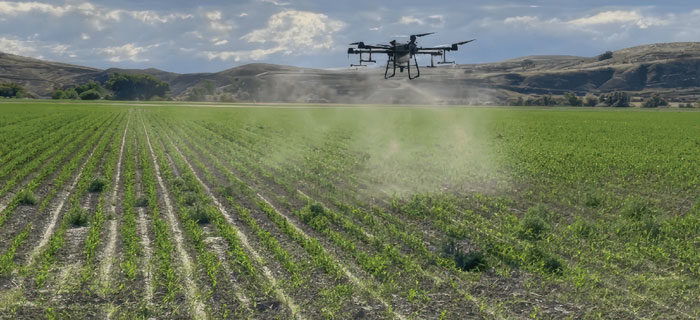No-Till Farmer
Get full access NOW to the most comprehensive, powerful and easy-to-use online resource for no-tillage practices. Just one good idea will pay for your subscription hundreds of times over.

Spraying the Field. A sprayer drone applies herbicides on the field. Droplet size is an important consideration when using drones for spraying because droplets that are too small will get lost in the wind, but droplets that are too large can bounce off the crop.
Drones aren’t just for crop scouting anymore. The use of drones and artificial intelligence is experiencing significant growth within agriculture as farmers deploy drones for spraying herbicides, fungicides and more on their crops
“There’s been a noticeable surge in the agricultural drone market with a rapid increase in partnerships and collaborations,” says Rachael Lowe, analyst for AgbioInvestor.
More than 15% of no-tillers who responded to No-Till Farmer’s 2023 No-Till Operational Practices Benchmark survey used drones. According to the 2023 CropLife/Precision Ag Adoption Survey, the use of drones, also known as unmanned aerial vehicles (UAVs), for application work is increasing among retailers, jumping from 14% in 2021 to 32% currently.
However, while drones hold great promise for no-tillers, they also bring forth their own set of challenges.
The fascination with drones in agriculture largely centers around their capacity to apply fungicides, herbicides, insecticides and other inputs without a compaction-causing pass across the field. Arthur Erickson, CEO and founder of drone spraying company Hylio, says the initial adoption of drone technology in agriculture was somewhat delayed, possibly due to limited payload capacity and underwhelming battery life.
Erickson says previously, batteries could only hold around 80 watt-hours per kilogram, contingent upon their quality. However, today’s batteries boast a capacity ranging from 200-250 watt-hours per kilogram. With this amount of power, Hylio’s drones have a carrying capacity between 2.6-18 gallons.
“Battery life and quality of life are paramount considerations if these technologies are to be embraced commercially,” Erickson says.
This fuels the…